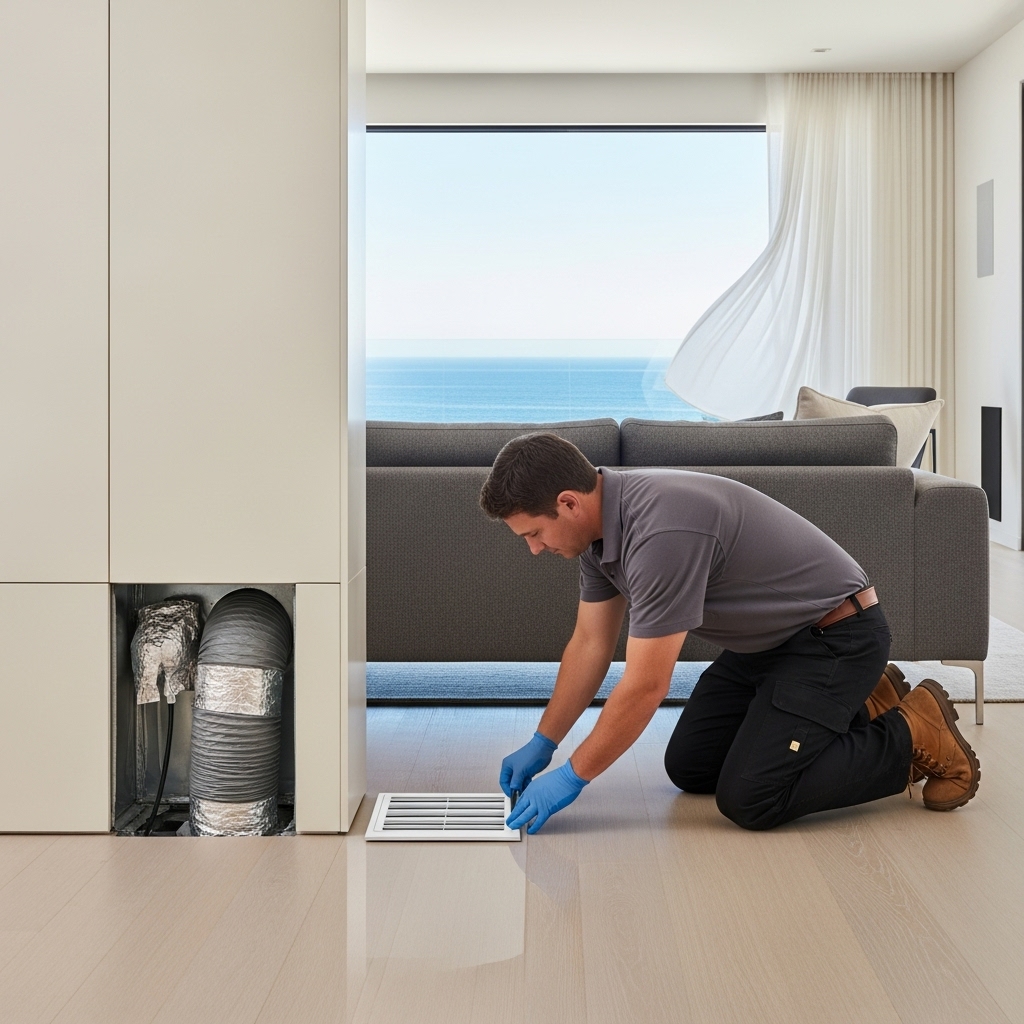For Malibu homeowners, air distribution is the quiet backbone of everyday comfort. When ducts are well designed, rooms feel consistent, noise is low, and the system sips energy rather than wasting it. When ducts are leaky, undersized, or deteriorated, you get hot-and-cold rooms, dust streaks, and higher energy use. This homeowner’s guide explains how to plan a successful upgrade in Malibu’s coastal environment, which materials and methods matter most, and what to expect during installation. As you begin your research, review the essentials of duct replacement so you can better evaluate options and set clear goals for your project.
Rather than focusing on dollar figures, we will explore the key drivers behind a solid outcome: home layout, access, design quality, materials, and the skill of your installation team. You will also find checklists that help you prepare, reduce disruption, and keep the process on schedule.
The Malibu Context: Coastal Air, Hillside Homes
Malibu’s setting is beautiful, but the ocean air and rugged terrain introduce special considerations for duct systems. Salt aerosols and humidity can contribute to corrosion, particularly in attics and crawlspaces. Hillside properties may have split levels, long runs, and varied sun exposure that complicate distribution. In some neighborhoods, wildfire smoke adds an extra reason to prioritize sealing and filtration.
These realities mean a successful project emphasizes durable materials, careful sealing, and smart routing. Your design should account for access challenges and target balanced airflow to all rooms, including areas that historically feel stuffy or drafty.
How to Know It Is Time to Upgrade
Many homeowners start considering an upgrade when they notice one or more of the following:
- Persistent temperature swings between rooms or floors.
- Noise from registers or ducts, especially whistling or rushing sounds.
- Dust streaks around grilles or visible gaps at seams.
- Musty odors, moisture concerns, or corrosion.
- Recurrent repair calls that never fully resolve comfort issues.
If several symptoms are present, a comprehensive replacement can address root causes rather than chasing isolated fixes.
Design First: The Blueprint for Comfort
Before anyone cuts or installs, insist on a design step. The team should verify equipment size, calculate room-by-room airflow needs, and map a route for trunks and branches that minimizes sharp turns. Balanced returns are essential; many homes benefit from additional return pathways to reduce pressure swings when doors close.
- Right-sized trunks and branches: Prevents noise and ensures each room receives appropriate airflow.
- Smooth transitions: Fewer abrupt elbows and better diffuser placement reduce drafts and hotspots.
- Return strategy: Adequate return capacity stabilizes pressure and supports quieter operation.
Material Options That Suit Malibu Homes
There is no one-size-fits-all material. A combination approach often performs best:
- Rigid metal: Excellent durability and smooth interior surfaces for airflow. Pair with robust sealing and insulation.
- Fiberglass-lined metal: Helps reduce noise on select runs when installed properly.
- High-quality flex: Ideal for short connections in tight areas; must be carefully supported and minimally bent.
Focus on materials and methods that tolerate coastal moisture and salt exposure. Corrosion-resistant fasteners and proper insulation coverage protect the system and discourage condensation.
Preparing Your Home and Family
Good preparation reduces schedule surprises. Clear access to attics, closets, and crawlspaces. Protect storage items from dust, and plan where technicians can stage tools and materials. If pets are present, arrange a comfortable space away from work zones. These small steps translate into smoother daily progress and fewer interruptions.
What to Expect During Installation
Most projects follow a predictable sequence. Understanding each step helps you ask the right questions and anticipate decisions:
- Assessment and planning: Document current issues, confirm airflow targets, and choose materials.
- Protection and staging: Cover walkways and work areas; stage ducts, hangers, and sealants.
- Removal: Extract old ductwork safely and note structural or envelope issues.
- Installation: Install new trunks and branches, maintain correct support spacing, and seal all joints.
- Insulation: Achieve full coverage without compression; pay attention to boots and penetrations.
- Balancing: Measure airflow, adjust dampers, and verify supply and return performance.
- Final walkthrough: Review results, maintenance guidance, and documentation.
Mid-Project Checkpoints
Once the old system is out, your team may discover opportunities to improve the plan—adding a return, moving a register away from a beam, or resizing a long branch. Agree on decision points to weigh trade-offs calmly and keep the schedule on track. During these checkpoints, many homeowners revisit the fundamentals of duct replacement to ensure the evolving plan still meets comfort, efficiency, and noise goals.
Balancing Comfort, Acoustics, and Air Quality
A successful system keeps temperatures even, operates quietly, and maintains clean indoor air. If wildfire smoke or allergens are concerns, discuss filtration strategies and how to size filter cabinets so airflow remains strong. If certain rooms are habitually warm or cool, consider diffuser style and placement as well as branch sizing. Small adjustments in the design phase can prevent persistent complaints later.
Permits and Inspections in Malibu
Local requirements typically call for permits and inspections to verify safety and performance standards. Expect inspectors to review support spacing, sealing methods, insulation levels, and accessibility. Working with a team familiar with Malibu’s process helps avoid delays and ensures your installation aligns with current codes.
Maintenance Tips After Installation
Protect your investment with straightforward upkeep:
- Change filters on schedule; if smoke events occur, inspect filters sooner.
- Keep returns unobstructed and vacuum grilles periodically.
- After heavy winds or attic work, visually check accessible runs and supports.
- Schedule occasional performance checks to confirm airflow stays within targets.
Common Mistakes to Avoid
- Skipping the design step and relying solely on equipment capacity.
- Allowing long, kinked flex runs that restrict airflow.
- Compressing insulation or leaving gaps at boots and penetrations.
- Under-sizing returns, which increases noise and reduces comfort.
- Neglecting accessibility for future maintenance.
Frequently Asked Questions
Q: How disruptive is the work?
A: Crews can manage dust and protect walkways with proper coverings. Expect activity in attics, crawlspaces, and mechanical rooms. Clear communication helps coordinate daily start and stop times.
Q: Can I keep parts of my old system?
A: Sometimes, but only if remaining sections are sized and sealed to integrate properly. A mixed system must be evaluated to avoid bottlenecks or noise.
Q: What about noise from vents?
A: Noise often indicates high velocity, tight turns, or undersized returns. A good design with smoother transitions and balanced returns typically quiets operation.
Q: Is special insulation needed near the coast?
A: Insulation must meet local standards and be installed without compression. Pair with corrosion-resistant fasteners and thorough sealing for durability.
Q: Do I need permits?
A: Local codes typically require permits and inspections. Work with providers familiar with Malibu’s process.
Q: How do smoke events affect my system?
A: Upgraded filtration and diligent sealing can reduce particulate infiltration. After major smoke exposure, many homeowners inspect filters sooner and verify duct integrity.
Your Malibu Home, Your Plan
The best projects start with clear objectives: comfort balance, quiet operation, and clean air. From there, a design-driven approach, materials that suit coastal conditions, and careful installation practices bring those goals to life. By preparing your home, coordinating schedules, and building in mid-project decision points, you can navigate the process smoothly and enjoy consistent, reliable comfort.
Speak With a Local Specialist
If you are ready to improve comfort and reliability in your Malibu home, start by documenting current symptoms and discussing airflow goals with a qualified team. Align on layout, materials, and insulation strategy, and ensure balancing and documentation are part of the plan. To take the next step with confidence, explore professional duct replacement options and schedule a consultation tailored to your home’s layout and coastal conditions.

